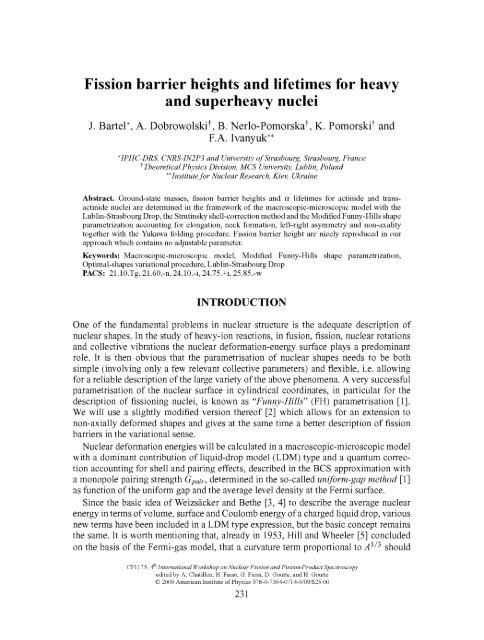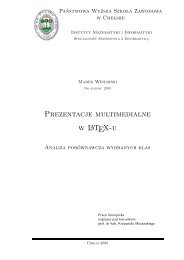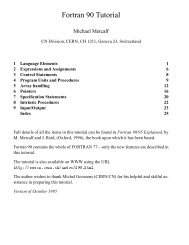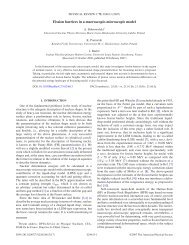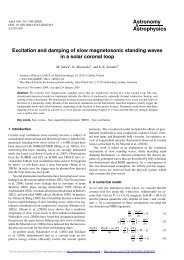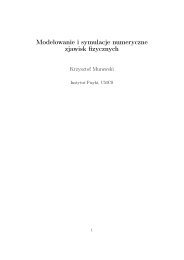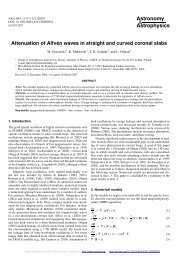Fission barrier heights and lifetimes for heavy and superheavy nuclei
Fission barrier heights and lifetimes for heavy and superheavy nuclei
Fission barrier heights and lifetimes for heavy and superheavy nuclei
Create successful ePaper yourself
Turn your PDF publications into a flip-book with our unique Google optimized e-Paper software.
<strong>Fission</strong> <strong>barrier</strong> <strong>heights</strong> <strong>and</strong> <strong>lifetimes</strong> <strong>for</strong> <strong>heavy</strong><br />
<strong>and</strong> super<strong>heavy</strong> <strong>nuclei</strong><br />
J. Bartel*, A. Dobrowolski''', B. Nerlo-Pomorska^, K. Pomorski''' <strong>and</strong><br />
F.A. Ivanyuk**<br />
*IPHC-DRS, CNRS-IN2P3 <strong>and</strong> University of Strasbourg, Strasbourg, France<br />
^TheoreticalPhysics Division, MCS University, Lublin, Pol<strong>and</strong><br />
** Institute <strong>for</strong> Nuclear Research, Kiev, Ukraine<br />
Abstract. Ground-state masses, fission <strong>barrier</strong> <strong>heights</strong> <strong>and</strong> a <strong>lifetimes</strong> <strong>for</strong> actinide <strong>and</strong> transactinide<br />
<strong>nuclei</strong> are determined in the framework of the macroscopic-microscopic model with the<br />
Lublin-Strasbourg Drop, the Strutinsky shell-correction method <strong>and</strong> the Modified Funny-Hills shape<br />
parametrization accounting <strong>for</strong> elongation, neck <strong>for</strong>mation, left-right asymmetry <strong>and</strong> non-axality<br />
together with the Yukawa folding procedure. <strong>Fission</strong> <strong>barrier</strong> height are nicely reproduced in our<br />
approach which contains no adjustable parameter<br />
Keywords: Macroscopic-microscopic model. Modified Funny-Hills shape parametrization.<br />
Optimal-shapes variational procedure, Lublin-Strasbourg Drop<br />
PACS: 21.10.Tg, 21.60.-n, 24.10.-i, 24.75.+i, 25.85.-w<br />
INTRODUCTION<br />
One of the fundamental problems in nuclear structure is the adequate description of<br />
nuclear shapes. In the study of <strong>heavy</strong>-ion reactions, in fusion, fission, nuclear rotations<br />
<strong>and</strong> collective vibrations the nuclear de<strong>for</strong>mation-energy surface plays a predominant<br />
role. It is then obvious that the parametrisation of nuclear shapes needs to be both<br />
simple (involving only a few relevant collective parameters) <strong>and</strong> flexible, i.e. allowing<br />
<strong>for</strong> a reliable description of the large variety of the above phenomena. A very successful<br />
parametrisation of the nuclear surface in cylindrical coordinates, in particular <strong>for</strong> the<br />
description of fissioning <strong>nuclei</strong>, is known as ''Funny-Hills" (FH) parametrisation [1].<br />
We will use a slightly modified version thereof [2] which allows <strong>for</strong> an extension to<br />
non-axially de<strong>for</strong>med shapes <strong>and</strong> gives at the same time a better description of fission<br />
<strong>barrier</strong>s in the variational sense.<br />
Nuclear de<strong>for</strong>mation energies will be calculated in a macroscopic-microscopic model<br />
with a dominant contribution of liquid-drop model (LDM) type <strong>and</strong> a quantum correction<br />
accounting <strong>for</strong> shell <strong>and</strong> pairing effects, described in the BCS approximation with<br />
a monopole pairing strength Gpair, determined in the so-called uni<strong>for</strong>m-gap method [1]<br />
as function of the uni<strong>for</strong>m gap <strong>and</strong> the average level density at the Fermi surface.<br />
Since the basic idea of Weizsacker <strong>and</strong> Bethe [3, 4] to describe the average nuclear<br />
energy in terms of volume, surface <strong>and</strong> Coulomb energy of a charged liquid drop, various<br />
new terms have been included in a LDM type expression, but the basic concept remains<br />
the same. It is worth mentioning that, already in 1953, Hill <strong>and</strong> Wheeler [5] concluded<br />
on the basis of the Fermi-gas model, that a curvature term proportional to A^l^ should<br />
CP1175, 4 International Workshop on Nuclear <strong>Fission</strong> <strong>and</strong> <strong>Fission</strong>-Product Spectroscopy<br />
edited by A. Chatillon, H. Faust, G. Fioni, D. Goutte, <strong>and</strong> H. Goutte<br />
© 2009 American Institute of Physics 978-0-7354-0714-5/09/$25.00<br />
231
e part of such a leptodermous expansion. This term was studied in Ref. [6], where<br />
its magnitude was adjusted to the at that time experimentally known fission-<strong>barrier</strong><br />
<strong>heights</strong>. Since the traditional liquid-drop model per<strong>for</strong>med already astonishingly well<br />
without that term, one could have expected that its inclusion plays a rather limited role.<br />
It turns out, however, that it leads to a significant improvement of the LDM <strong>for</strong>mula, as<br />
demonstrated in the so called Lublin-Strasbourg Drop (LSD) [7] with a r.m.s. deviation<br />
with experimental masses of {5M) = 0.698 MeV, as compared to 0.732 MeV within<br />
the traditional approach <strong>and</strong>, even more spectacular, with a r.m.s. deviation <strong>for</strong> fission<strong>barrier</strong><br />
<strong>heights</strong> <strong>for</strong> <strong>nuclei</strong> with Z > 70 of {5VB) = 0.88 MeV as compared to 5.58 MeV<br />
[7] without the inclusion of a curvature term. The LSD mass estimates of Ref. [7] were<br />
evaluated with the microscopic energy corrections taken from the mass table of Moller<br />
at al. [8]. The above quoted discrepances in the estimates of the fission <strong>barrier</strong> <strong>heights</strong><br />
can be slightly reduced (see Ref. [9]) when one introduces a de<strong>for</strong>mation dependent<br />
congruence energy as proposed in Ref. [10]. It is in this approach that fission <strong>barrier</strong>s<br />
are going to be evaluated in what follows.<br />
SHAPE PARAMETRIZATIONS FOR FISSIONING NUCLEI<br />
A shape parametrization fulfilling the above requirement of being both accurate <strong>and</strong><br />
simple <strong>and</strong> which has proven extremely sucessfull in the context of nuclear fission are<br />
the so-called "Funny-Hills" shapes [1]<br />
2 j Rlc^ {l-u^){A + au + Bu^) , B>0<br />
'^'^"'^\Rlc^{l-u^){A+au)exp{Bc^u^),<br />
B
ensures volume conservation of the de<strong>for</strong>med nucleus. We refer hereafter to (3) as the<br />
''ModifiedFunny-Hills" (MFH) parametrisation. In a similar way as <strong>for</strong> the original FH<br />
parametrisation we can define a neck parameter h e.g. by<br />
h = \[B-{c-\] (5)<br />
such that /i = 0 corresponds <strong>for</strong> actinide <strong>nuclei</strong> roughly to the average LDM path to<br />
fission in the {c, h} de<strong>for</strong>mation space.<br />
Apart from the de<strong>for</strong>mation parameters c, B <strong>and</strong> a which have a similar (although not<br />
identical) meaning as in the original FH parametrisation, a new parameter a has been<br />
introduced in Eq. (3). A minimization of the LDM energy along the fission paths yields<br />
a value of a in the vicinity of a = 1.<br />
An alternative way to describe nuclear shapes, which is not relying on any shape<br />
parametrization, was proposed by V. Strutinsky [11]. It consists in defining a profile<br />
function, like Ps{z), <strong>and</strong> searching <strong>for</strong> the minimum of the LDM energy under the<br />
constraint that the volume V <strong>and</strong> the elongation are fixed<br />
5p, {E^OM-hV-^Rn)=^ (6)<br />
where Aj <strong>and</strong> Aj are the corresponding Lagrange multipliers <strong>and</strong> the elongation parameter<br />
_Kj2 can be chosen e.g. as the distance between the centers of mass of left <strong>and</strong> right<br />
part of the nucleus, or any other measure of the elongation (as the mass quadrupole<br />
moment). The minimization with respect to the profile function leads then to an integrodifferential<br />
equation which can be solved iteratively [11] (see Ref. [12] <strong>for</strong> details).<br />
. . . . 1 . . . . 1 . . . . 1 . . . .<br />
/ ^ = ^ \D=O-75 :<br />
LU<br />
LU<br />
0.010<br />
0.005<br />
0.000<br />
.<br />
/ \ "<br />
/ \'- .<br />
FH, B-minimization<br />
MFH, B-minimization<br />
"optimal" shapes<br />
0.5 1.0 1.5 2.0<br />
R.„/R„<br />
V\<br />
\ -<br />
2.5<br />
FIGURE 1. LDM de<strong>for</strong>mation energy obtained with Strutinsky's optimal shapes as compared to Funny<br />
Hills <strong>and</strong> Modified Funny Hills shapes <strong>for</strong> a Liquid-Drop fissility parameter of x = 0.75.<br />
Applying this method enables us to test the quality of a given shape parametrization<br />
as done in Ref. [12]. It turns out that (after minimization in B) the MFH shapes are<br />
closest to the so-called optimal shapes obtained by the Strutinsky variational procedure<br />
as shown in Fig. 1. Other shape parametrizations, like the expansion in spherical<br />
harmonics or the Cassinian ovaloids [14], on the contrary, fail to reproduce the optimal<br />
shapes of the fission <strong>barrier</strong>s, unless a very large number of terms is included.<br />
233
The parametrisations (1) <strong>and</strong> (3) which we introduced till now are restricted to axially<br />
de<strong>for</strong>med shapes. It is well known, however, that in the actinide region, non-axial shapes<br />
are favoured near the first saddle. Without attempting to describe such shapes in the fully<br />
general case, we assume that the cross section perpendicular to the z axis is an ellipse<br />
with half axes a^ <strong>and</strong> Uy which, of course, depend on z. In polar coordinates<br />
2 2<br />
^^'(^'
a diffuseness correction <strong>and</strong> an exchange contribution of the N-body wavefunction. A<br />
modern version of the Liquid-Drop model is presented below.<br />
The fluctuating part 5E^^ of the nuclear energy is usually evaluated in the <strong>for</strong>m<br />
^•E'mic = ^•E'shell + ^•E'pair ' (11)<br />
where the first term, refered to as the shell-correction energy, contains that part of the<br />
fluctuation which is due to the nuclear shell structure, <strong>and</strong> where the second term is due<br />
to the pairing correlations between the nucleons.<br />
For a system like the atomic nucleus which is composed of two sorts of fermions,<br />
protons <strong>and</strong> neutrons, the calculation of shell-correction <strong>and</strong> pairing energy needs to be<br />
carried out <strong>for</strong> both types of nucleons with 8E^^^^^ <strong>and</strong> 8E^^^ getting contributions from<br />
neutrons <strong>and</strong> protons.<br />
To determine single-particle spectra of a given nucleus at a given de<strong>for</strong>mation, as is<br />
needed both in the Strutinsky shell correction energy <strong>and</strong> in the BCS pairing treatment,<br />
one has to define single-particle potentials <strong>for</strong> any shape. To do that we prefer not to<br />
use the prescription of ref. [1] which defined single-particle densities <strong>and</strong> potentials as<br />
Fermi type functions perpendicular to the equivalent sharp surface, given e.g. by Eq.<br />
(9), since such a prescription does not allow <strong>for</strong> an unambiguously definition of these<br />
quantities <strong>for</strong> necked-in shapes appearing in the vicinity of the scission configuration.<br />
Neutron <strong>and</strong> proton densities as well as the corresponding single-particle potentials can,<br />
however, be unambiguously defined by folding the de<strong>for</strong>med equivalent sharp surface<br />
with an appropriate folding function [16] (see also Ref. [13] <strong>for</strong> details).<br />
The Lublin-Strasbourg Drop Model<br />
In our macroscopic-microscopic model the average nuclear binding energy is determined<br />
using the Lublin-Strasbourg-Drop (LSD) [7] as a function of mass <strong>and</strong> charge<br />
number (via the isospin parameter I) <strong>and</strong> the nuclear de<strong>for</strong>mation<br />
£^,(Z,7V;def) =flvoi(l - K-vo/)^ + asur(l -<br />
K,^f)A^I^B,„,{def)<br />
+ acur (1 - Kcur/2)^'''^5cur(def) + | ^ -^5coul(def) - C4 |- -£'cong , (12)<br />
where the parameters, listed in Table 1, are adjusted to all 2766 experimental binding<br />
energies taken from Ref. [17] using the microscopic corrections from [8] <strong>and</strong> the congruence<br />
energy iicong estimated according to [18]. The functions isur(def), icur(def),<br />
-5coui(def) defined as the variation, relative to the spherical shape, of the nuclear surface,<br />
curvature <strong>and</strong> Coulomb energies, can be evaluated <strong>for</strong> any nuclear shape [19] <strong>and</strong>, in<br />
particular, <strong>for</strong> the MFH shapes used in this work.<br />
It has been demonstrated that Eq. (10) v^'ithE^^^ (12) <strong>and</strong> 8E^:^^ taken from [8] is not<br />
only able to describe the experimental binding energies of all presently known <strong>nuclei</strong><br />
with a very good accuracy [7], but experimental fission <strong>barrier</strong> <strong>heights</strong> as well [9] as<br />
pointed out above.<br />
235
TABLE 1.<br />
avoi =-15.4920 MeV<br />
asur= 16.9707 MeV<br />
acur = 3.8602 MeV<br />
To = 1.21725 fm<br />
Parameters entering the LSD model<br />
K-voi= 1.8601<br />
Ksui= 2.2938<br />
Kcur = -2.3764<br />
C4 =0.9181 MeV<br />
FISSION BARRIER HEIGHTS AND a-DECAY LIFETIMES<br />
Using a gradient method (see Ref. [13] <strong>for</strong> details), we have located all physically<br />
relevant stationary points <strong>for</strong> a sample of 18 actinide <strong>nuclei</strong>. Fig. 2 displays the fission<strong>barrier</strong><br />
<strong>heights</strong> <strong>for</strong> these <strong>nuclei</strong> calculated as the difference between the total ground<br />
state <strong>and</strong> the saddle-point energy. In the lower part of the figure the difference of the<br />
experimental <strong>and</strong> theoretical <strong>barrier</strong> <strong>heights</strong> is given. We conclude that our macroscopic-<br />
><br />
^<br />
CD<br />
><br />
2<br />
m<br />
X<br />
CO<br />
7.5<br />
7<br />
6.5<br />
6<br />
5.5<br />
5<br />
4.5<br />
4<br />
2<br />
1<br />
0<br />
-1<br />
-<br />
-3<br />
n 23ep^<br />
n<br />
232T-„<br />
n 234y<br />
+ 2S*U<br />
+ 232Th<br />
+ ^*PU<br />
,<br />
D<br />
D<br />
D<br />
23Bp^<br />
236^<br />
+ 2S*Th<br />
+ 23Bp„<br />
B<br />
D<br />
+<br />
^<br />
238^<br />
238..<br />
240^ni<br />
H 2lJgn<br />
240y<br />
+ 2*"U<br />
140 142 144 146 148 150<br />
,<br />
N<br />
+ »«cm<br />
+ »*Pu<br />
,<br />
n 24ep^<br />
B gSgm<br />
* 2Sg["<br />
+ Pu<br />
,<br />
n 260(,m<br />
+ 26"cm<br />
,<br />
J<br />
-<br />
-<br />
•:<br />
-<br />
-,<br />
i<br />
-<br />
152 154 156<br />
FIGURE 2. Theoretical <strong>barrier</strong> <strong>heights</strong> Sth of actinide <strong>nuclei</strong> from ^^^Th to ^'"Cf (upper) <strong>and</strong> difference<br />
between experimental [20] <strong>and</strong> theoretical <strong>barrier</strong> <strong>heights</strong> (lower part) as function of neutron number<br />
microscopic approach with the LSD macroscopic energy, the Strutinsky shell correction<br />
<strong>and</strong> the pairing treatment in terms of the BCS approach with the uni<strong>for</strong>m-gap method<br />
<strong>for</strong> the determination of the pairing strength is able to reproduce the fission <strong>barrier</strong><br />
<strong>heights</strong> on the average within less than 1 MeV. Since our theoretical estimates <strong>for</strong> the<br />
<strong>barrier</strong> <strong>heights</strong> are almost all higher than the experimental values, this discrepancy will<br />
still be reduced e.g. when taking the effect of different proton-neutron de<strong>for</strong>mations<br />
into account, as has been demonstrated in Ref. [13] where it was shown that such<br />
an additional degree of freedom in the macroscopic-microscopic approach can lead<br />
to an energy gain up to about 1 MeV. Note that in our calculations no zero-point<br />
vibration energy is included since the macroscopic-microscopic model or the Hartree-<br />
Fock-Bogoliubov type approach are based on a variational method which by definition<br />
yields an upper bound of the nuclear ground-state energy <strong>and</strong> no further corrections are<br />
there<strong>for</strong>e needed. The obtained accuracy is practically of the same quality as the <strong>barrier</strong><br />
236
<strong>heights</strong> estimates of Ref [20]. Keep in mind, however, that the parameters of the finite<br />
range LDM approach [21] were re-adjusted to reproduce experimental <strong>barrier</strong>s in the<br />
best possible way. The parameters of the LSD model used in our approch were, on the<br />
contrary, adjusted only to experimentally known gound-state masses. In this respect it is<br />
quite gratifying to notice the good capacity of our method to reproduce fission <strong>barrier</strong>s,<br />
which seems to indicate that the essential physics is correctly contained in our approach<br />
<strong>and</strong> this, as pointed out be<strong>for</strong>e, with a minimal number of adjustable parameters.<br />
801 6<br />
801 8<br />
802 0<br />
802 2<br />
802 4<br />
802 6<br />
802 8<br />
803 0<br />
803 2<br />
803 4<br />
803 6<br />
803 8<br />
804 0<br />
804 2<br />
804 4<br />
804 6<br />
804 8<br />
805 0<br />
805 2<br />
805 4<br />
805 6<br />
805 8<br />
806 0<br />
FIGURE 3. Energy l<strong>and</strong>scape of the nucleus Pu at a de<strong>for</strong>mation corresponding to the second saddle<br />
point as function of the left-right asymmetry parameter a <strong>and</strong> the non-axiality parameter 77.<br />
It is also quite interesting to investigate the importance of taking left-right asymmetry<br />
<strong>and</strong> non axiality into account when calculating fission <strong>barrier</strong> <strong>heights</strong>. For that purpose<br />
we have calculated the energy gain obtained including, in addition to the elongation <strong>and</strong><br />
neck parameters c <strong>and</strong> /i, also the left-right asymmetry <strong>and</strong> non-axiality parameters a<br />
<strong>and</strong> 77 • It is generally admitted that non-axiality plays a role in the vicinity of the first<br />
<strong>barrier</strong> <strong>and</strong> that left-right asymmetry is of mayor importance at the second <strong>barrier</strong>. It<br />
turns out, however, in our study that both these degrees of freedom are important as<br />
well at the first as at the second <strong>barrier</strong> <strong>and</strong> that the commulative effect of both is of<br />
the order of 1-2 MeV at the first, but reaches up to 7 MeV at the second <strong>barrier</strong>. We<br />
would like to attract the reader's attention to the fact that even if at a given de<strong>for</strong>mation<br />
point, as at the second saddle, the minimal energy turns out to be axially symmetric,<br />
the energy l<strong>and</strong>scape in our 4-dimensional de<strong>for</strong>mation space might show another local<br />
minimum at almost the same energy which exhibits a substantial non-axiality, as shown<br />
in Fig. 3 <strong>for</strong> the nucleus ^'^''Pu at a de<strong>for</strong>mation corresponding to the second saddle. This<br />
second local minimum found here at fixed values of c <strong>and</strong> h is believed to belong to<br />
a different fission valley <strong>and</strong> that one would need to carry out a dynamical calculation<br />
taking mass parameters into account to make any reasonable predictions about a fission<br />
path or fission lifetime.<br />
Motivated by our quite encouraging results on fission-<strong>barrier</strong> <strong>heights</strong> caused, as we<br />
believe, by a correct description of nuclear de<strong>for</strong>mation energies, we can make some<br />
predictions on a-decay half lives. For such an estimate the Viola-Seaborg expression<br />
[22] is often used. Recently an even simpler expression [23, 24] has been proposed<br />
which <strong>for</strong> even-even <strong>nuclei</strong> reads<br />
log,oTa{Z,N)<br />
aZ<br />
VQa{Z,N)<br />
-hZ- (13)<br />
237
where a = 1.5372,b = —0.1607,c = —44.0718. With this expression we obtain the<br />
results displayed in Fig. 4 which show again a nice agreement with experimental data.<br />
FIGURE 4.<br />
Comparison between experimental <strong>and</strong> theoretical a-decay half lives.<br />
REFERENCES<br />
1. M. Brack, et al.. Rev. Mod. Phys. 44, 320 (1972).<br />
2. K. Pomorski <strong>and</strong> J. Bartel, Int. Jour Mod. Phys. E15, 460 (2006).<br />
3. C.F. V. Weizsacker, Z. Phys. 96, 431 (1935).<br />
4. H. A. Bethe <strong>and</strong> F. Bacher, Rev. Mod. Phys. 8, 426 (1936).<br />
5. D.L. Hill <strong>and</strong> J.A. Wheeler, Phys. Rev 89, 1102 (1953).<br />
6. H.V. Groote <strong>and</strong> E. Hilf, Nucl. Phys. A129, 513 (1969).<br />
7. K. Pomorski <strong>and</strong> J. Dudek, Phys. Rev. C67, 044316 (2003).<br />
8. P MoUer, J.R. Nix, W.D. Myers, <strong>and</strong> W.J. Swiatecki, At. Data Nucl. Data Tables 59, 185 (1995).<br />
9. K. Pomorski <strong>and</strong> J. Dudek, Int. Jour. Mod. Phys. E13, 107 (2004).<br />
10. W.D. Myers <strong>and</strong> W.J. Swiatecki, Nucl. Phys. A612, 249 (1997).<br />
11. V. Strutinsky,N.Y. Lyashchenko <strong>and</strong>N.A. Popov, Nucl. Phys. 46, 659 (1963).<br />
12. F. Ivanyuk <strong>and</strong> K. Pomorski Phys. Rev C79, 054327 (2009).<br />
13. A. Dobrowolski, K. Pomorski <strong>and</strong> J. Bartel, Phys. Rev C75, 024613 (2007).<br />
14. V.V. Pashkevich,Nucl. Phys. A169, 275 (1971).<br />
15. V. M. Strutinsky, Sov. J. Nucl. Phys. 3, 449 (1966); Nucl. Phys. A95, 420 (1967).<br />
16. K.T.R. Davies <strong>and</strong> J.R. Nix, Phys. Rev. C14, 1977 (1976).<br />
17. M. S. Antony, Nuclide Chart 2002, Strasbourg 2002, Impressions Fran9ois, 103 Route de Marienthal,<br />
Haguenau.<br />
18. W. D. Myers <strong>and</strong> W J. Swiatecki, Nucl. Phys. A601, 141 (1996).<br />
19. W. Hasse <strong>and</strong> W D. Myers, Geometricl Relationships of Macroscopic Nuclear Physics, Springer<br />
Verlag, Heidelberg, 1988.<br />
20. P MoUer, A. Sierk, <strong>and</strong> A. Iwamoto, Phys. Rev. Lett. 92, 072501 (2004).<br />
21. H.J. Krappe, J.R. Nix, <strong>and</strong> A.J. Sierk, Phys. Rev C20, 992 (1979).<br />
22. V.E. Viola <strong>and</strong> G.T. Seaborg, Jour. Inorg. Nucl. Chem. 28, 741 (1966).<br />
23. A. Parkhomenko <strong>and</strong> A. Sobiczewski, Acta Phys. Pol. B36, 3095 (2005).<br />
24. A. Sobiczewski <strong>and</strong> K. Pomorski, Prog. Part. Nucl. Phys. 58, 292 (2007).<br />
238


